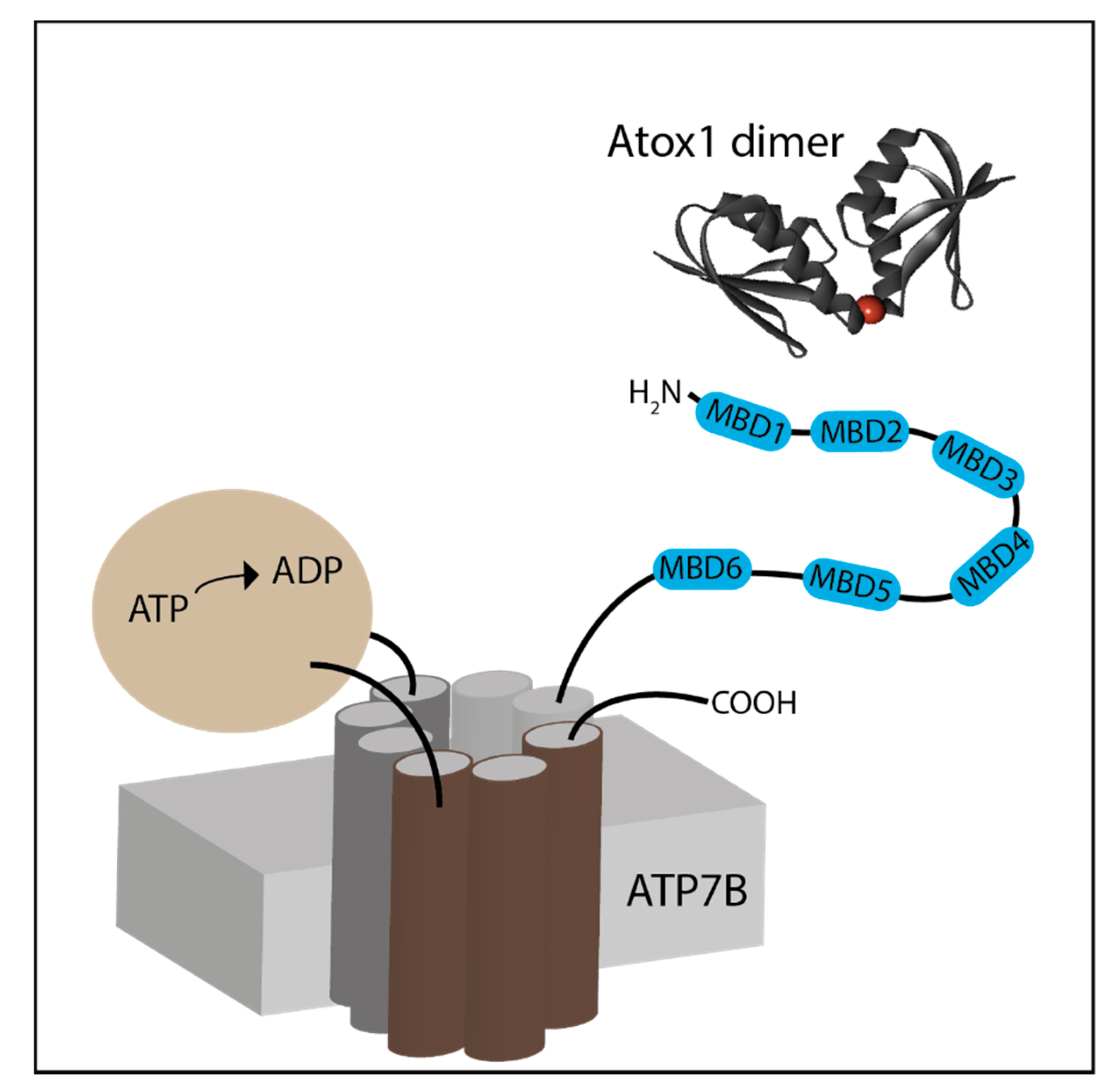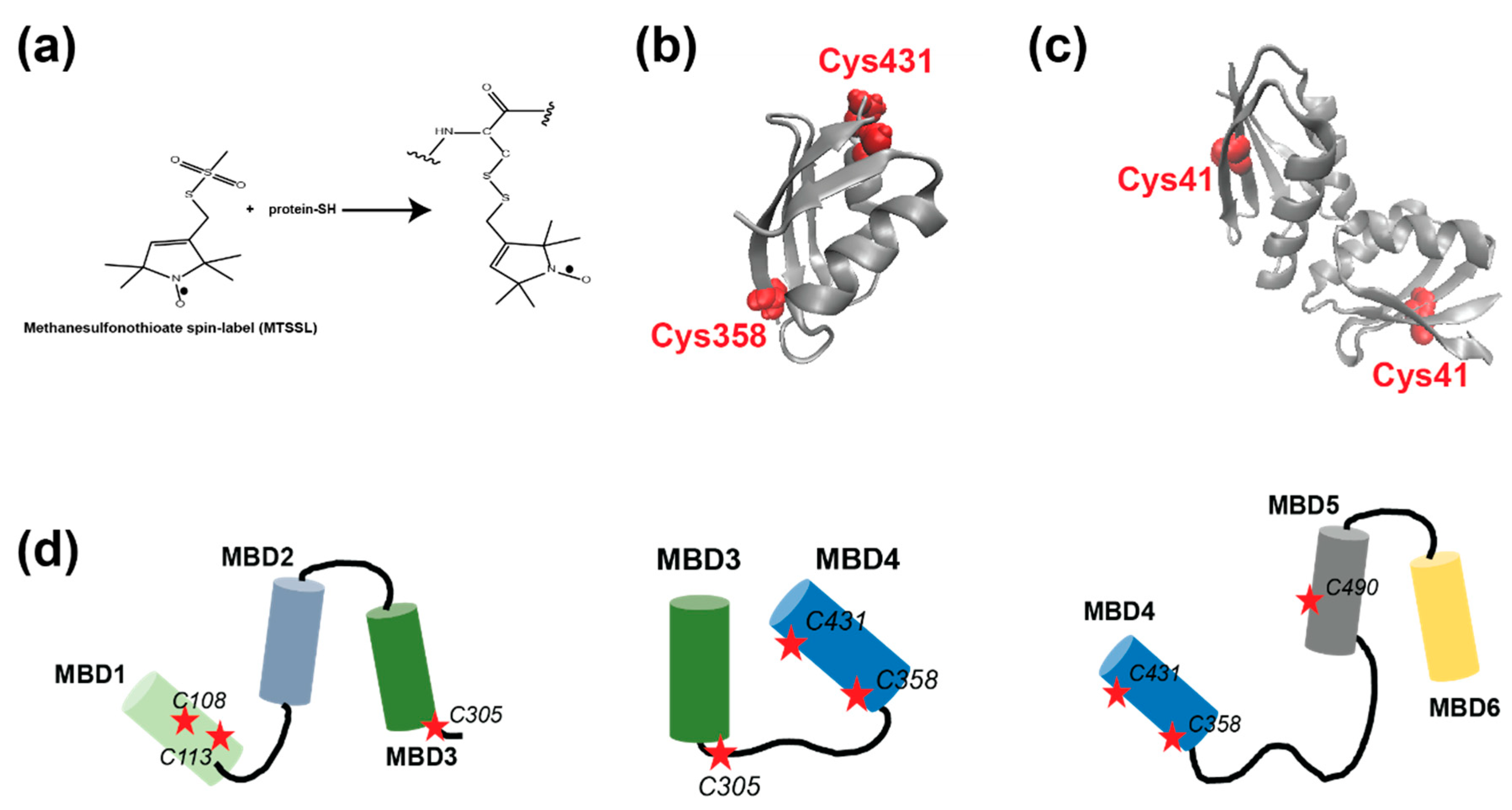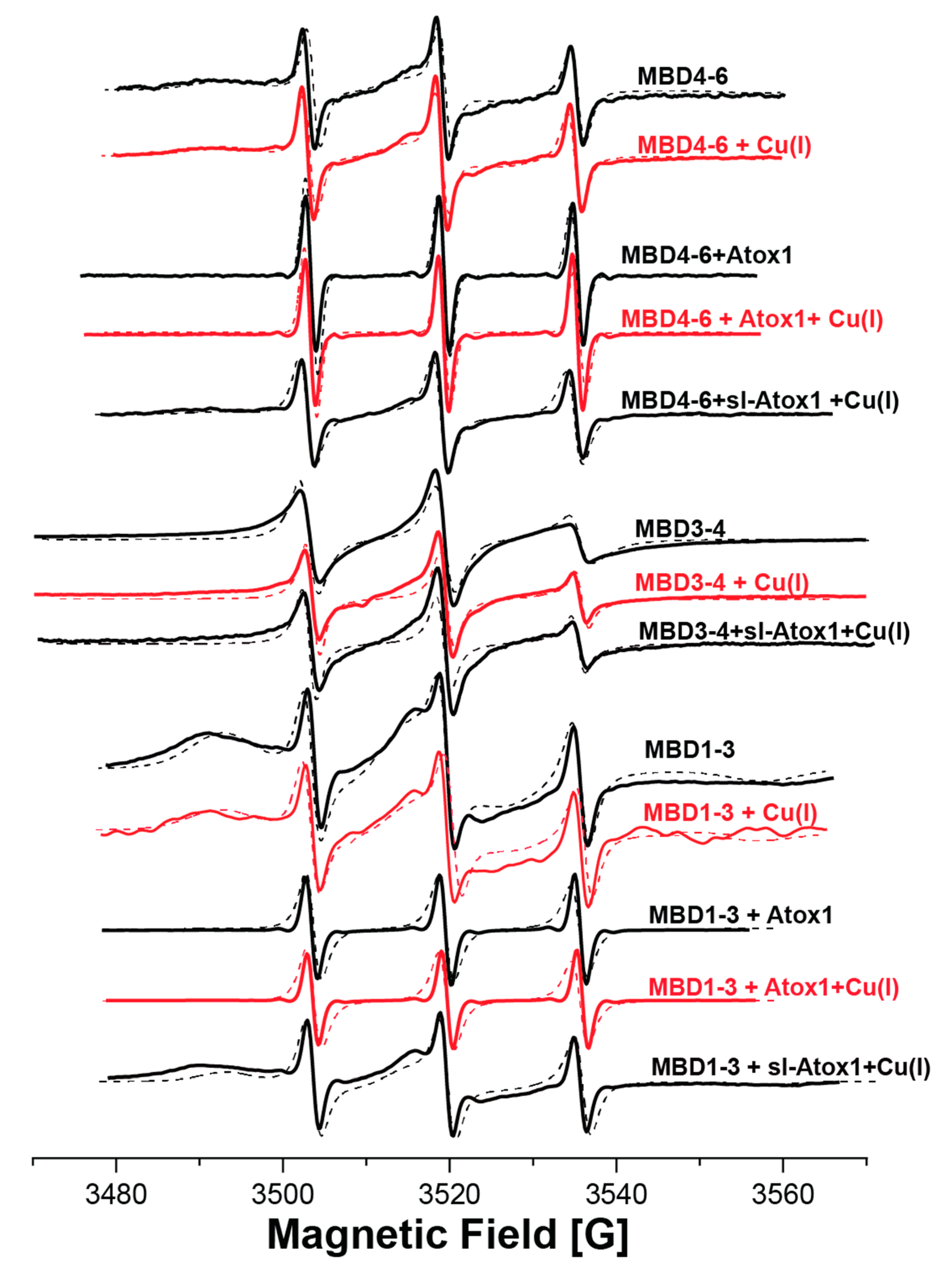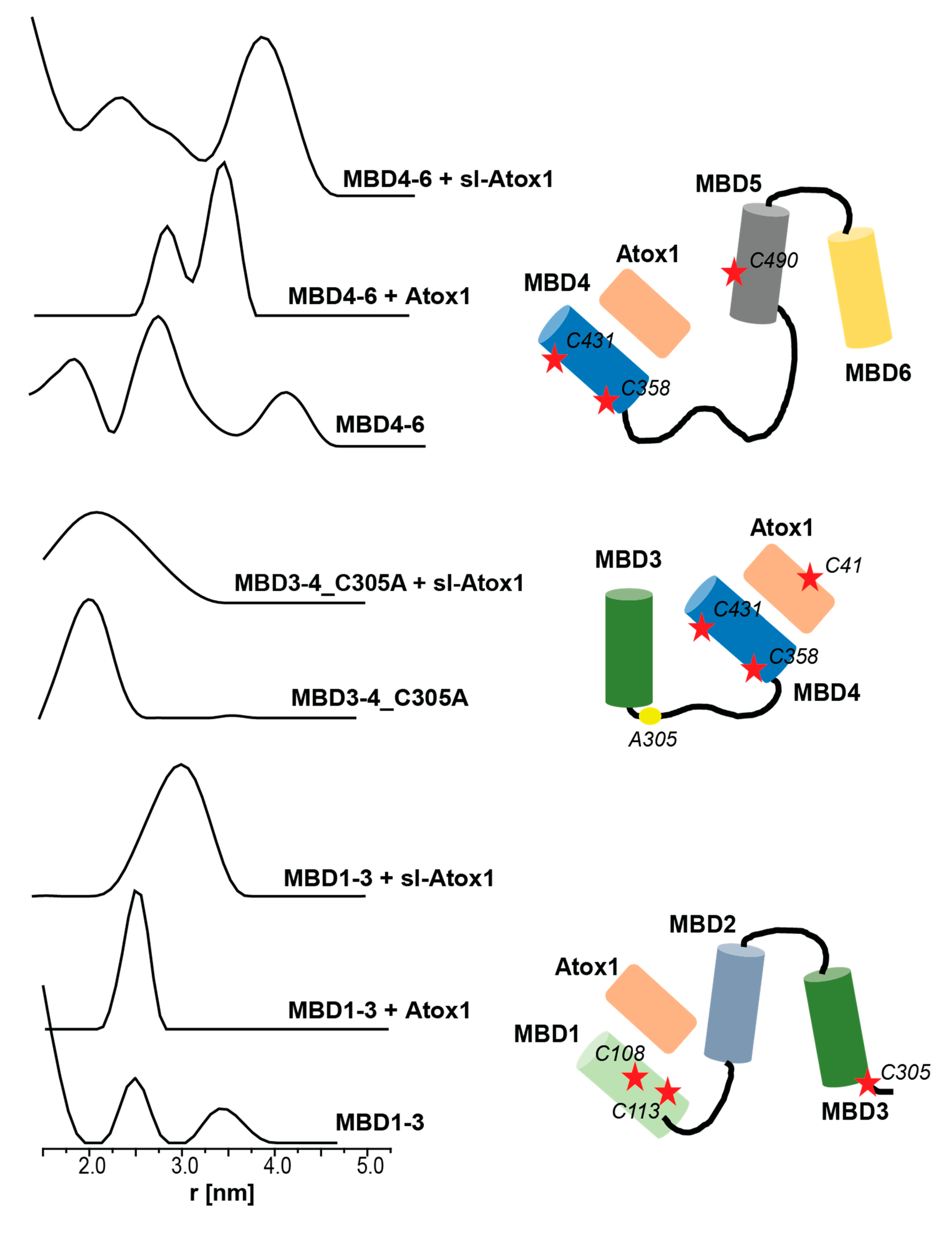An EPR Study on the Interaction between the Cu(I) Metal Binding Domains of ATP7B and the Atox1 Metallochaperone
Abstract
1. Introduction
2. Results
2.1. Probing the Interaction between the MBDs of ATP7B and the Metallochaperone Atox1 by CW-EPR at RT
2.2. Probing the Interaction between the MBDs of ATP7B and the Metallochaperone Atox1 by Distance Pulsed EPR Measurements (DEER)
3. Discussion
4. Materials and Methods
4.1. Cloning, Expression and Purification of ATP7B 1-3; 3-4; 4-6 Metal Binding Domains
4.2. Spin Labeling
4.3. Cu(I) Addition
4.4. X-band CW EPR Experiments
4.5. Q-band DEER Experiments
4.6. Circular Dichroism Characterization
5. Conclusions
Author Contributions
Funding
Conflicts of Interest
Abbreviations
| Cys | Cysteine |
| WT | Wild type |
| CD | Circular dichroism |
| EPR | Electron paramagnetic resonance |
| CW-EPR | Continuous wave electron paramagnetic resonance |
| DEER | Double electron–electron resonance |
| RT | Room temperature |
| O.N. | Overnight |
| sl | Spin-labeled |
| MBD | Metal binding domain |
| NMR | Nuclear magnetic resonance |
| SDSL | Site-directed spin labeling |
| MTSL | Methanesulfonothiolate |
References
- Burkhead, J.L.; Gogolin Reynolds, K.A.; Abdel-Ghany, S.E.; Cohu, C.M.; Pilon, M. Copper Homeostasis. New Phytol. 2009, 182, 799–816. [Google Scholar] [CrossRef] [PubMed]
- Cerpa, W.; Varela-Nallar, L.; Reyes, A.E.; Minniti, A.N.; Inestrosa, N.C. Is there a Role for Copper in Neurodegenerative Diseases? Mol. Aspect. Med. 2005, 26, 405–420. [Google Scholar] [CrossRef] [PubMed]
- Banci, L.; Bertini, I.; Cantini, F.; Ciofi-Baffoni, S. Cellular copper distribution: A mechanistic systems biology approach. Cell Mol. Life Sci. 2010, 67, 2563–2589. [Google Scholar] [CrossRef] [PubMed]
- Boal, A.K.; Rosenzweig, A.C. Structural Biology of Copper Trafficking. Chem. Rev. 2009, 109, 4760–4779. [Google Scholar] [CrossRef] [PubMed]
- De Feo, C.J.; Aller, S.G.; Unger, V.M. A Structural Perspective on Copper Uptake in Eukaryotes. Biometals 2007, 20, 705–716. [Google Scholar] [CrossRef] [PubMed]
- Barnes, N.; Bartee, M.Y.; Braiterman, L.; Gupta, A.; Ustiyan, V.; Zuzel, V.; Kaplan, J.H.; Hubbard, A.L.; Lutsenko, S. Cell-specific trafficking suggests a new role for renal ATP7B in the intracellular copper storage. Traffic 2009, 10, 767–779. [Google Scholar] [CrossRef]
- Lutsenko, S. Human copper homeostasis: A network of interconnected pathways. Curr. Opin. Chem. Biol. 2010, 14, 211–217. [Google Scholar] [CrossRef]
- Lutsenko, S. Copper trafficking to the secretory pathway. Metallomics 2016, 8, 840–852. [Google Scholar] [CrossRef]
- Wernimont, A.; Huffman, D.L.; Lamb, A.L.; O’Halloran, T.V.; Rosenzweig, A.C. Structural basis for copper transfer by the metallochaperone for the Menkes/Wilson disease proteins. Nat. Struct. Biol. 2000, 7, 766–771. [Google Scholar]
- Walker, J.M.; Tsivkovskii, R.; Lutsenko, S. Metallochaperone Atox1 transfers copper to the NH2-terminal domain of the Wilson’s disease protein and regulates its catalytic activity. J. Biol. Chem. 2002, 277, 27953–27959. [Google Scholar] [CrossRef]
- Achila, D.; Banci, L.; Bertini, I.; Bunce, J.; Ciofi-Baffoni, S.; Huffman, D.L. Structue of human Wilson protein domains 5 and 6 and their interplay with domain 4 and the copper chaperone HAH1 in copper uptake. Proc. Nat. Acad. Sci. USA 2006, 103, 5729–5734. [Google Scholar] [CrossRef] [PubMed]
- Banci, L.; Bertini, I.; Cantini, F.; Massagni, C.; Migliardi, M.; Rosato, A. An NMR study of the interaction of the N-terminal cytoplasmic tail of the Wilson disease protein with copper(I)-HAH1. J. Biol. Chem. 2009, 284, 9354–9360. [Google Scholar] [CrossRef] [PubMed]
- Kuhlbrandt, W. Biology, structure and mechanism of P-type ATPases. Nat. Rev. Mol. Cell Biol. 2004, 5, 282–295. [Google Scholar] [CrossRef] [PubMed]
- Huang, Y.; Nokhrin, S.; Hassanzadeh-Ghassabeh, G.; Yu, C.H.; Yang, H.; Barry, A.N.; Tonelli, M.; Markley, J.L.; Muyldermans, S.; Dmitriev, O.Y.; et al. Interactions between metal-binding domains modulate intracellular targeting of Cu(I)-ATPase ATP7B, as revealed by nanobody binding. J. Biol. Chem. 2014, 289, 32682–32693. [Google Scholar] [CrossRef]
- Arioz, C.; Li, Y.; Wittung-Stafshede, P. The six metal binding domains in human copper transporter, ATP7B: Molecular biophysics and disease-causing mutations. Biometals 2017, 30, 823–840. [Google Scholar] [CrossRef]
- Shanmugavel, K.P.; Wittung-Stafshede, P. Copper relay path through the N-terminus of Wilson disease protein, ATP7B. Metallomics 2019, 11, 1472–1480. [Google Scholar] [CrossRef]
- Loudianos, G.; Dessi, V.; Lovicu, M.; Angius, A.; Nurchi, A.; Sturniolo, G.C.; Marcellini, M.; Zancan, L.; Bragetti, P.; Akar, N.; et al. Further delineation of the molecular pathology of Wilson disease in the Mediterranean population. Hum. Mutat. 1998, 12, 89–94. [Google Scholar] [CrossRef]
- de Bie, P.; Muller, P.; Wijmenga, C.; Klomp, L.W.J. Molecular pathogenesis of Wilson and Menkes disease: Correlation of mutations with molecular defects and disease phenotypes. J. Med. Genet. 2007, 44, 673–688. [Google Scholar] [CrossRef]
- Hamza, I.; Schaefer, M.; Klomp, L.W.; Gitlin, J.D. Interaction of the copper chaperone HAH1 with the Wilson disease protein is essential for copper homeostasis. Proc. Natl. Acad. Sci. USA 1999, 96, 13363–13368. [Google Scholar] [CrossRef]
- Yatsunyk, L.A.; Rosenzweig, A.C. Cu(I) binding and transfer by the N terminus of the Wilson disease protein. J. Biol. Chem. 2007, 282, 8622–8631. [Google Scholar] [CrossRef]
- Banci, L.; Bertini, I.; Cantini, F.; Della-Malva, N.; Migliardi, M.; Rosato, A. The Different Intermolecular Interactions of the Soluble Copper-binding Domains of the Menkes Protein, ATP7A. J. Biol. Chem. 2007, 282, 23140–23146. [Google Scholar] [CrossRef] [PubMed]
- van Dongen, E.M.; Klomp, L.W.; Merkx, M. Copper-dependent protein-protein interactions studied by yeast two-hybrid analysis. Biochem. Biophys. Res. Commun. 2004, 323, 789–795. [Google Scholar] [CrossRef] [PubMed]
- Qasem, Z.; Pavlin, M.; Ritacco, I.; Gevorkyan-Airapetov, L.; Magistrato, A.; Ruthstein, S. The pivotal role of MBD4-ATP7B in the human Cu(I) excretion path as revealed by EPR experiments and all-atom simulations. Metallomics 2019, 11, 1288–1297. [Google Scholar] [CrossRef] [PubMed]
- Cater, M.A.; Forbes, J.; La Fontaine, S.; Cox, D.; Mercer, J.F. Intracellular trafficking of the human Wilson protein: The role of the six N-terminal metal-binding sites. Biochem. J. 2004, 380, 805–813. [Google Scholar] [CrossRef] [PubMed]
- Magistrato, A.; Pavlin, M.; Qasem, Z.; Ruthstein, S. Copper trafficking in eukaryotic systems: Current knowledge from experimental and computational efforts. Curr. Opin. Struct. Biol. 2019, 58, 26–33. [Google Scholar] [CrossRef]
- Columbus, L.; Hubbell, W.L. A new spin on protein dynamics. Trends Biochem. Sci. 2002, 27, 288–295. [Google Scholar] [CrossRef]
- Hubbell, W.L.; Mchaourab, H.S.; Altenbach, C.; Lietzow, M.A. Watching proteins move using site-directed spin labeling. Structure 1996, 4, 779–783. [Google Scholar] [CrossRef]
- Pavlin, M.; Qasem, Z.; Sameach, H.; Gevorkyan-Airapetov, L.; Ritacco, I.; Ruthstein, S.; Magistrato, A. Unraveling the Impact of Cysteine-to-Serine Mutations on the Structural and Functional Properties of Cu(I)-Binding Proteins. Int. J. Mol. Sci. 2019, 20, 3462. [Google Scholar] [CrossRef]
- Shenberger, Y.; Yarmiayev, V.; Ruthstein, S. Exploring the Interaction between the Human Copper Transporter, CTR1, C-terminal Domain and a Methionine Motif in the Presence of Cu(I) and Ag(I) Ions, using EPR Spectrosocopy. Mol. Phys. 2013, 111, 2980–2991. [Google Scholar] [CrossRef]
- Cai, Q.; Kusnetzow, A.K.; Hubbell, W.L.; Haworth, I.S.; Gacho, G.P.C.; Van Eps, N.; Hideg, K.; Chambers, E.J.; Qin, P.Z. Site-directed spin labeling measurements of nanometer distances in nucleic acids using a sequence-independent nitroxide probe. Nucl. Acids Res. 2006, 34, 4722–4730. [Google Scholar] [CrossRef]
- Mchaourab, H.S.; Oh, K.J.; Fang, C.J.; Hubbell, W.L. Conformation of T4 lysozyme in studied by site-directed spin labeling. Biochemistry 1997, 36, 307–316. [Google Scholar] [CrossRef] [PubMed]
- Shin, Y.-K.; Levinthal, C.; Levinthal, F.; Hubbell, W.L. Colicin E1 binding to membranes: Time-resolved studies of spin-labeled mutants. Science 1993, 259, 960–963. [Google Scholar] [CrossRef] [PubMed]
- Vamvouka, M.; Cieslak, J.; Van Eps, N.; Hubbell, W.; Gross, A. The Structure of the Lipid-Embedded Potassium Channel Voltage Sensor Determined by Double-Electron-Electron Resonance Spectroscopy. Protein Sci. 2008, 17, 506–517. [Google Scholar] [CrossRef] [PubMed]
- Schnider, D.J.; Freed, J.H. Biological Magnetic Resonance. Spin Labeling; Plenum: New York, NY, USA, 1989; Volume 8. [Google Scholar]
- Stoll, S.; Schweiger, A. EasySpin, a Comprehensive Software Package for Spectral Simulation and Analysis in EPR. J. Magn. Reson. 2006, 178, 42–55. [Google Scholar] [CrossRef]
- Levy, A.R.; Yarmiayev, V.; Moskovitz, Y.; Ruthstein, S. Probing the Structural Flexibility of the Human Copper Metallochaperone Atox1 Dimer and Its Interaction with the CTR1 C-Terminal Domain. J. Phys. Chem. B 2014, 118, 5832–5842. [Google Scholar] [CrossRef]
- Pannier, M.; Veit, S.; Godt, A.; Jeschke, G.; Spiess, H.W. Dead-time free measurement of dipole-dipole interactions between electron spins. J. Magn. Reson. 2000, 142, 331–340. [Google Scholar] [CrossRef]
- Yu, C.H.; Yang, N.; Bothe, J.; Tonelli, M.; Nokherin, S.; Dolgova, N.V.; Braiterman, L.; Lutsenko, S.; Dmitriev, O.Y. The metal chaperone Atox1 regulates the activity of the human copper transporter ATP7B by modulating domain dynamics. J. Biol. Chem. 2017, 292, 18169–18177. [Google Scholar] [CrossRef]
- Badarau, A.; Firbank, S.J.; McCarthy, A.A.; Banfield, M.J.; Dennison, C. Visualizing the metal-binding versatility of copper trafficking sites. Biochemistry 2010, 49, 7798–7810. [Google Scholar] [CrossRef]
- Huffman, D.L.; O’Halloran, T.V. Function, structure, and mechanism of intracellular copper trafficking proteins. Annu. Rev. Biochem. 2001, 70, 677–701. [Google Scholar] [CrossRef]
- Fatemi, N.; Korzhnev, D.M.; Velyvis, A.; Sarkar, B.; Forman-Kay, J.D. NMR characterization of copper-binding domains 4-6 of ATP7B. Biochemistry 2010, 49, 8468–8477. [Google Scholar] [CrossRef]
- Levy, A.R.; Nissim, M.; Mendelman, N.; Chill, J.; Ruthstein, S. Ctr1 Intracellular Loop Is Involved in the Copper Transfer Mechanism to the Atox1 Metallochaperone. J. Phys. Chem. B 2016, 120, 12334–12345. [Google Scholar] [CrossRef] [PubMed]
- Levy, A.R.; Turgeman, M.; Gevorkyan-Aiapetov, L.; Ruthstein, S. The structural flexibility of the human copper chaperone Atox1: Insights from combined pulsed EPR studies and computations. Protein Sci. 2017, 26, 1609–1618. [Google Scholar] [CrossRef] [PubMed]





| Sample | A-Tensor [MHz] (±1.0 MHz) | τ (Correlation Time (Sec)) (±0.05 × 10−9) | Exchange/Dipolar Interaction [MHz] (±0.1 MHz) | % Species (±1.0%) |
|---|---|---|---|---|
| MBD1-3 | [25 25 88] | 1 × 10−10 | 5.0 | 10% |
| [25 25 92] | 1 × 10−6 | 6.0 | 90% | |
| MBD1-3 + Cu(I) | [25 25 88] | 1 × 10−10 | 5.0 | 15% |
| [25 25 92] | 1 × 10−6 | 6.0 | 85% | |
| MBD1-3 + Atox1 | [25 25 88] | 1 × 10−10 | 5.0 | 95% |
| [25 25 92] | 1 × 10−6 | 6.0 | 5% | |
| MBD1-3 + Atox1 + Cu(I) | [25 25 88] | 1 × 10−10 | 5.0 | 95% |
| [25 25 92] | 1 × 10−6 | 6.0 | 5% | |
| MBD1-3+ sl-Atox1 + Cu(I) | [25 25 88] | 1 × 10−10 | 5.0 | 30% |
| [25 25 92] | 1 × 10−6 | 6.0 | 70% | |
| MBD3-4 | [25 25 90] | 1 × 10−9 | 5.0 | 98% |
| [25 25 86] | 1 × 10−9 | 0.0 | 2% | |
| MBD3-4 + Cu(I) | [25 25 90] | 1 × 10−9 | 5.0 | 85% |
| [25 25 88] | 0.6 × 10−10 | 0.0 | 15% | |
| MBD3-4 + sl-Atox1 + Cu(I) | [25 25 90] | 1 × 10−9 | 5.0 | 85% |
| [25 25 88] | 0.6 × 10−10 | 0.0 | 15% | |
| MBD4-6 | [25 25 88] | 1 × 10−10 | 3.0 | 16% |
| [25 25 92] | 1 × 10−6 | 6.0 | 84% | |
| MBD4-6 + Cu(I) | [25 25 88] | 1 × 10−10 | 3.0 | 16% |
| [25 25 92] | 1 × 10−6 | 6.0 | 84% | |
| MBD4-6 + Atox1 | [25 25 90] | 6 × 10−9 | 0.0 | 100% |
| MBD4-6 + Atox1 + Cu(I) | [25 25 90] | 6 × 10−9 | 0.0 | 100% |
| MBD4-6 + sl-Atox1 + Cu(I) | [25 25 88] | 1 × 10−10 | 5.0 | 50% |
| [25 25 92] | 1 × 10−6 | 6.0 | 50% |
© 2020 by the authors. Licensee MDPI, Basel, Switzerland. This article is an open access article distributed under the terms and conditions of the Creative Commons Attribution (CC BY) license (http://creativecommons.org/licenses/by/4.0/).
Share and Cite
Zaccak, M.; Qasem, Z.; Gevorkyan-Airapetov, L.; Ruthstein, S. An EPR Study on the Interaction between the Cu(I) Metal Binding Domains of ATP7B and the Atox1 Metallochaperone. Int. J. Mol. Sci. 2020, 21, 5536. https://doi.org/10.3390/ijms21155536
Zaccak M, Qasem Z, Gevorkyan-Airapetov L, Ruthstein S. An EPR Study on the Interaction between the Cu(I) Metal Binding Domains of ATP7B and the Atox1 Metallochaperone. International Journal of Molecular Sciences. 2020; 21(15):5536. https://doi.org/10.3390/ijms21155536
Chicago/Turabian StyleZaccak, Michael, Zena Qasem, Lada Gevorkyan-Airapetov, and Sharon Ruthstein. 2020. "An EPR Study on the Interaction between the Cu(I) Metal Binding Domains of ATP7B and the Atox1 Metallochaperone" International Journal of Molecular Sciences 21, no. 15: 5536. https://doi.org/10.3390/ijms21155536
APA StyleZaccak, M., Qasem, Z., Gevorkyan-Airapetov, L., & Ruthstein, S. (2020). An EPR Study on the Interaction between the Cu(I) Metal Binding Domains of ATP7B and the Atox1 Metallochaperone. International Journal of Molecular Sciences, 21(15), 5536. https://doi.org/10.3390/ijms21155536





